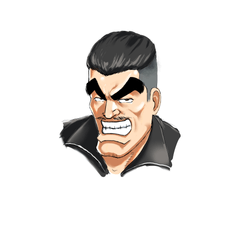Composition with consideration for skill and weakness (how to create a composition with two or more characters)
Here's a quick question.
Below are two images.
It seems like B ate A-san's ice cream without permission...
Of course, A-san is furious! She confronts B-san -- this is the illustration, but in terms of composition, which one looks more natural, ① or ②?**
The correct answer is ②!
Comparing the two images, doesn't it feel better with A on the right and B on the left?
We can understand the situation in ①, but doesn't A's momentum in closing in on B seem weaker than in ②?
When there are multiple characters, there is actually a set strategy for whether they should be placed on the left or right.
This is actively used not only in illustrations and manga, but also in anime, movies, commercials, and more.
The way to do this is-
--Be aware of good and bad points.
This time, we will introduce some important tips for good and bad points when deciding on a composition.
The basic rule is "upper hand is right and lower hand is left"
Ute... kamite. Strong people, superiors, older people, people in higher positions.
Shimote... shimote. Weak people, subordinates, younger people, people in lower positions.
And the composition is stable with ute on the right and shimote on the left.
In this illustration, A is bigger and would probably win if they were to fight.
So A is on the right and B is on the left.
And if you place the right on the right and the left on the left, you'll get a natural composition.
These methods have also been used in classical performing arts such as Kabuki.
On stage, for example, the superior/boss sits on the right side from the audience's perspective, and the subordinate/subordinate sits on the left.
In Rakugo, where one person plays two roles, the superior role will speak facing ← from the audience's perspective, and the inferior role will speak facing →.
Poor ← Good composition creates a sense of speed
By being mindful of skill and lack of skill in your composition, you can create a sense of speed in your drawing.
In the cartoon below, a truck gets caught by a squid robot...
In this scene, a black robot uses a scythe to cut it in half and save him, but what do you think if you compare ① and ② below?
Both have the same effects applied to them to create a sense of speed, but doesn't ①, with its directional flow, seem to give the impression of speed?
I think this is also used in car commercials.
If you look at the commercials of several car manufacturers, don't you see a lot of scenes with cars driving in the left and right direction?
It's just a matter of feeling, but I think it's because cars driving in the left and right direction give the impression of speed.
--So, if you pay close attention to your good and bad points, you can create a composition that gives a sense of speed.
The reversal scene is more exciting.
When the weaker player counterattacks well, it makes for a thrilling comeback scene.
Look at the illustration above.
It's a scene of a woman delivering a counter-kick to a golem several times her size --
Which do you think has more impact?
The correct answer is --
--②.
In this illustration, the big, tough-looking golem is the strong player.
The woman is at a disadvantage, but she manages to kick the golem away!
The strong-looking strong character is on the stable right, while the weaker character counterattacks from the left... This creates a big change in the one-sided flow from strong to weak, adding excitement to the reversal scene.
Also, in manga, adding a frame where the strong and weak characters switch can make the transition between offense and defense smoother.
Earlier, the black robot on the top side cut the squid robot in half.
But then a new enemy appeared and knocked the robot flying with a single blow!
The black robot that was supposed to be on the top side now moves to the left side, and the situation is reversed.
At this point, by inserting pieces that switch between the top and bottom sides, you can naturally switch between the top and bottom sides, reversing the roles of offense and defense.
summary
Basics for deciding on a composition with two or more people
・The basic rule is "top person on the right, bottom person on the left"
・A bottom person ← top person composition creates a sense of speed
・Adds excitement to reverse scenes
If you master the basics of top person and bottom person, you can create a sense of stability, speed, or vibrant change in illustrations, manga, anime, etc.
However, if you try to force this into every scene, the picture will become monotonous, so we hope you will use it at key points and as needed.
























Comment